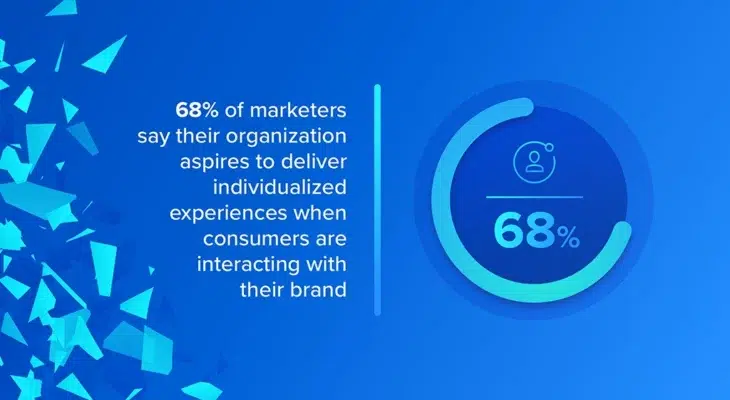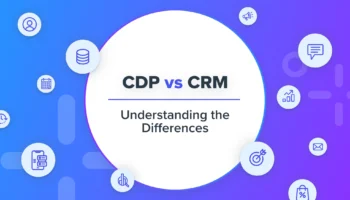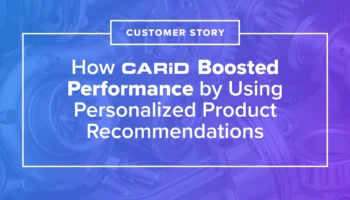Within marketing, and even business in general, there has been a paradigm shift. Historically, marketers were confined to a channel-centric lense, and so, that was how we marketed to customers. But, with advances to technology, web browsing trends, and trends set by key players like Amazon and Netflix, marketers can now deliver customer-centric marketing — which is when marketers deliver messaging to customers on the best channel, where and when they want to be engaged. The shift from offline to online commerce has made it clear that the brands that will continue to thrive are those who can put the customer at the core of everything they do.
5 Reasons Your Marketing Needs to Be Customer-Centric

1. YOUR COMPETITORS ARE LIKELY POSITIONING THEMSELVES TO BE CUSTOMER-CENTRIC
Our report, Marketer vs. Martech found that 81% of marketers using AI/machine-based learning for customer-centric marketing personalization report to exceed revenue goals by over 30%. That’s an astounding leap in revenue — and it proves that if you’re not investing in personalization, you lose out on a huge opportunity for growth. And it’s no wonder that tailored personalization has become so popular when businesses, especially in ecommerce where brands are trying to keep up with the likes of Amazon. If you’d like to learn more about how Blueshift does ecommerce, check out our resource here.
2. CUSTOMERS WANT TO RECEIVE 1:1 MESSAGING AND RESPOND WELL TO IT
We all want the “VIP” experience — your marketing should embody that. And frankly, consumers are getting fed up with overly generalized batch-and-blast marketing. 70% of millennials report feeling frustrated with irrelevant and impersonal messaging. And speaking of Amazon again, 47% of consumers check there if the brand they’re shopping with doesn’t provide product suggestions that are relevant.
Providing personalized experiences leads directly to accelerated growth and increased revenue for your business — Accenture reports that 91% of consumers say they are more likely to shop with brands that provide offers and recommendations that are relevant to them. But, consumers also expect this personalization to meet them where they are.
3. CUSTOMERS ARE NOW MULTI-CHANNEL BUYERS
Think about the last purchase you made of a non-routine item. You probably did some research on the product and brand before clicking add to cart right? Your customers are doing the exact same thing when it comes time to interact with your brand. They may be drawn in by an email or ad on social media, but they’ll then browse your site (and your competitors’ sites), log on to your mobile app, etc.
In fact, 70% of consumers interact with 3 or more channels before making a purchase decision. It’s key that your marketing is customer-centric rather than channel-centric, so these browsers aren’t hit with disparate messaging as they switch from channel to channel.
4. YOU’RE LIKELY ALREADY COLLECTING THE DATA YOU NEED TO MAKE THE SHIFT
The foundation of customer-centric marketing is first-party data. And while collecting and unifying customer data might feel like an insurmountable process, to begin with, you might actually be further along than you think.
With tools like Blueshift’s Customer Data Activation Platform (CDAP) it’s easier than ever for marketers to pull data from all their existing tools into one, unified solution. Marketers can access real-time data from their CRMs, websites, catalogs, and data lakes within our Single Customer Views. Don’t fret on creating huge initiatives with your data science teams to get the data you need to pull off customer-centric marketing. We’re here to bring the power of data-driven marketing to you (no engineering expertise needed).
5. THERE ARE MORE ATTAINABLE AI-DRIVEN PLATFORMS THAN EVER TO HELP
Much of the research around AI and marketing has been involving enterprise-level companies and large scale deals. This has led to the incorrect assumption that artificial intelligence is just for teams with considerable engineering resources and deep pockets. Businesses of all sizes, some even with little to no data scientists, have found success using AI. There has been a 14X increase in the number of active AI startups since 2000 — and many of these companies make up the 7,000 (and counting) martech platforms that exist today.
The key is finding a technology partner that uses AI and machine learning in order to elevate engineering needs while providing powerful, automated customer journeys. Blueshift’s CDAP does just that — but don’t take our word for it, check out how Skillshare and Artifact Uprising are utilizing our intuitive AI for themselves.


